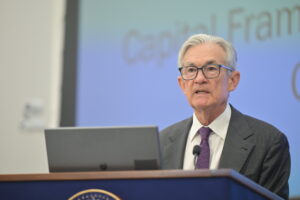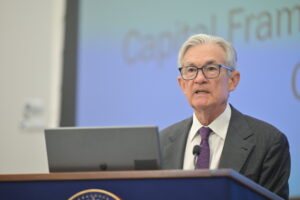
Despite mounting pressure from President Trump to cut rates, the Federal Open Market Committee (FOMC) voted yesterday to hold the target range for its policy rate constant at 4.25 to 4.5 percent, where it has remained since December 2024. Notably, two members of the committee — Vice Chair for Supervision Michelle Bowman and Governor Christopher Waller — dissented, favoring a 25-basis point cut. It was the first time that two Board members have dissented since 1993.
Fed Chair Jerome Powell’s comments at the post-meeting press conference largely echoed his earlier statements this year. He reaffirmed the Committee’s view that the economy remains strong, with the labor market at or near maximum employment, while acknowledging that inflation remains slightly above the Fed’s 2 percent target.
Pointing to newly released GDP data, Powell noted that while the economy grew at an annualized rate of three percent in the second quarter, averaging that figure with the weaker first quarter suggests that growth has slowed overall. The economy is now on track to expand by just 1.2 percent in 2025, down from 2.5 percent in 2024. Powell attributed the slowdown to weaker consumer spending growth but emphasized that business investment is running ahead of last year’s pace.
The labor market remains in balance, according to Powell, who noted that the unemployment rate remains low — around 4.1 percent — and has fluctuated only minimally over the past year. At the same time, wage growth, while moderating, continues to outpace inflation. In short, the Committee appears satisfied with progress on the employment side of the Federal Reserve’s dual mandate.
Powell acknowledged that although inflation has moderated substantially over the past three years, it remains above the Fed’s 2 percent target. He noted that data from both the Consumer Price Index and the Personal Consumption Expenditures Price Index show that the overall price level rose by 2.5 percent over the past 12 months, driven in part by higher prices on tariffed goods. While short-term inflation expectations have risen in response to recent tariff developments, Powell emphasized that longer-term expectations remain well anchored around the Fed’s target.
He also cautioned that it is still too early to determine the full effect of the tariffs on the economy. The Committee’s baseline view, he reiterated, is that the inflationary effect is likely to be short-lived: the tariffs will cause a one-time upward shift in the price level, not a sustained increase in inflation. Nonetheless, Powell noted that if the effects prove more persistent than expected, the Committee may need to reassess its baseline.
The Fed’s obligation, Powell emphasized, is to ensure that long-run inflation expectations remain anchored at its 2 percent target and to prevent one-time increases in the price level from turning into sustained inflation. He argued that the Fed is well-positioned to adopt a wait-and-see approach to the inflationary effects of the tariffs — a view I have recently criticized as reflecting a fundamental misunderstanding of how monetary policy works. Nonetheless, Powell maintained that the Fed’s current policy stance is appropriate given the ongoing inflation risk.
Interestingly, Powell also signaled that the Committee remains attentive to risks on the employment side of its mandate — presumably those arising from an overly restrictive policy stance. This marks a subtle shift from recent press conferences, where he emphasized that the Fed would, if necessary, prioritize price stability, rightly arguing that it is a precondition for a strong labor market.
Looking ahead, the Fed is expected to conclude its framework review by the end of the summer — potentially signaling a return to its pre-2020 inflation-targeting regime. The FOMC will meet again in September. Markets currently assign about a 45 percent chance to a 25-basis-point rate cut, though that probability is likely to shift in the coming weeks amid economic uncertainty and ongoing political pressure.

